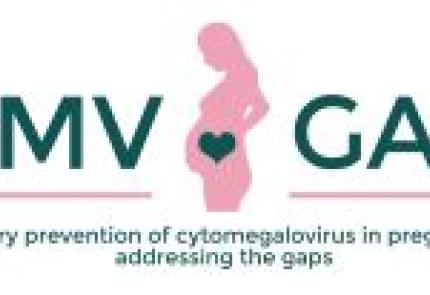Specific objectives:
1. To engage with policy makers and key stakeholders to identify policy priorities and evidence gaps that need to be filled to routinely recommend CMV risk reduction measures in pregnancy
2. To determine the proportion of women at risk of primary CMV infection in pregnancy and the rates of CMV infection in the first trimester of pregnancy by testing blood samples routinely collected at antenatal booking at representative sites in England.
3. To investigate the ways of implementing, sustaining, or enhancing CMV educational interventions in real world routine antenatal care settings.
4. To explore the feasibility of conducting a future large implementation study to test the efficacy of delivering a CMV educational intervention in ‘real-world’ routine antenatal care settings.
How was the research carried out?
This project comprised of three activities all employing different methods:
Activity 1 - the research team carried out a policy roundtable meeting with key stakeholders to identify policy priorities and research gaps. Policy stakeholders were invited to respond to key findings and to shape recommendations to local and national policy audiences. The combined work of the research team and policy stakeholders will be used to create policy briefs. Our stakeholders were supportive to introduce CMV in routine antenatal education.
Activity 2 - the team aimed to determine the proportion of women at risk of primary CMV infection in pregnancy and the rates of CMV infection in the first trimester of pregnancy by testing blood samples routinely collected at antenatal booking at representative sites in England.
Activity 3 - The research team investigated ways of implementing, sustaining, or enhancing a CMV educational intervention in real-world routine antenatal care settings. The feasibility of conducting a future large implementation study to test the efficacy of delivering a CMV educational intervention in ‘real-world’ routine antenatal care settings was explored. Work was done with a Public Involvement Group to gather feedback for previously developed CMV educational film from a diverse and underrepresented group to direct future modifications to the film. In-depth interviews were carried out with antenatal staff and other healthcare professionals, from various NHS sites, and digital providers who engage in antenatal education, to further explore barriers and facilitators to engagement with CMV education, as well as sustainability potential beyond a future implementation study.
Background to the study
This study built upon findings of previous study (RACE-FIT) funded by National Institute of Health Research, Research for Patient Benefit (NIHR RfPB), where a film-based intervention was co-produced by families affected by CMV and pregnant women. The feasibility study for a larger scale randomised controlled trial was conducted in St George's University NHS Trust. This study investigated policy and implementation gaps to reduce risk of CMV in pregnancy and reduce burden of neuro-disability in children. It also considered issues of inclusion and diversity in antenatal education and sought to engage with inequities in maternal health among women living in communities of social disadvantage and ethnic diversity, which are of particular interest and relevance to people living in south London.
Our collaborators
This project had numerous collaboration channels at different phases of the research. The research team included people from Kingston University, Southampton University hospital (PI), University of Cambridge, University College London and, CMV Action, a charity who have also had continued involvement in this research.
We also collaborated with St. George’s University Hospital NHS Foundation Trust, Newcastle Upon Tyne NHS Foundation Trust, Sheffield Teaching Hospitals NHS Foundation Trust, University Hospital Coventry and Warwickshire NHS Trust, Norfolk and Norwich University Hospitals NHS Foundation Trust, University Hospital Southampton NHS Foundation Trust and University Hospitals Bristol NHS Foundation Trust.
How patients and the public are involved in the research
Public involvement is embedded throughout the project. The PPI members provided advice and feedback in the planning, implementation and evaluation of our work. Through the course of the work we continued to consult with families living with a child with CMV, Charity CMV Action and preganant women from a range of diverse backgrounds and charities working with under-represented communities (such as Mosaic Trust, Maternity Voices, Sure Start centre in Southampton (Pickles Coppice) and Royal College of Obstetricians and Gynaecologists.
Professor Tushna Vandrevala, Kingston University who co-led this study says: “By carrying out this research to identify these gaps, we can ensure future successful inclusion of CMV education into routine antenatal care. Now is the time to engage with policy makers and other stakeholders to ensure that women have the advice they need to protect them and their unborn children from CMV infection.”
Potential benefits of the research
Despite being the most common infection that is caught before birth - and the potentially devasting consequences of CMV - most people have not heard of CMV. Many women have heard about ways to prevent other rare infections – for example avoiding cat litter and soft cheese - but never been told about ways to avoid CMV. Our previous research has shown that pregnant women and families affected by CMV express shock and anger about not being told about CMV.
There are no national policies or recommendations about how to reduce the risk of catching CMV whilst pregnant and therefore, this information is not routinely given to pregnant women in the NHS. We engaged with policy makers and other key stakeholders to work out the gaps that need to be filled in order for all pregnant women to be told about ways to reduce the risk of catching CMV whilst pregnant with the aim to provide a clear action plan to fill these gaps.
We anticipate testing routinely collected and stored blood samples collected at antenatal booking appointments, to find out the numbers of women who catch CMV early in pregnancy. This will demonstrate the burden of CMV that we could potentially prevent as a result of policy action and the women we are failing by policy inaction. We have also explored and identified ways to meaningfully integrate information about CMV into routine antenatal care, to ensure we do not overload women, or the midwives and obstetricians caring for them.
The study is funded by the NIHR Policy Research Programme. It is due to be completed in May 2022.



